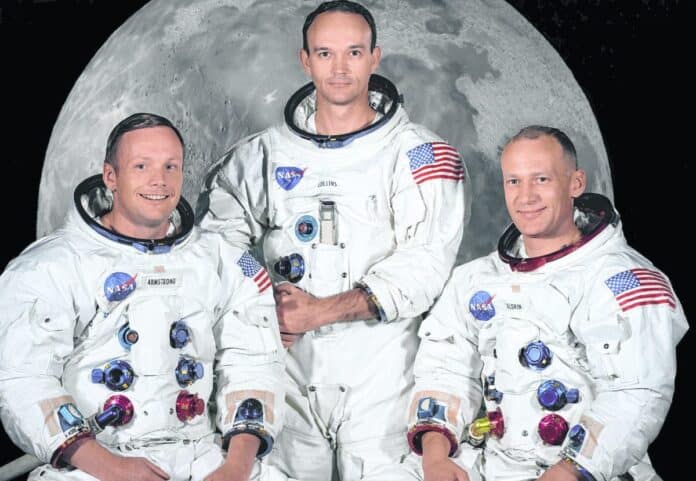
GREENFIELD — They weren’t alive when Neil Armstrong, Buzz Aldrin and Michael Collins made history.
Still, Alissa Schultze and her husband, Anthony, brought their two young children to a presentation earlier this week showcasing the 50th anniversary of the Apollo 11 moon landing, which happened 50 years ago today.
“We just like learning about it and really anything that has to do with space,” Alissa Schultze said.
[sc:text-divider text-divider-title=”Story continues below gallery” ]
Click here to purchase photos from this galleryTheir daughter, who attends J.B. Stephens Elementary School, had learned some about the first men on the moon at school this past year and came home talking about the event. So her parents were keenly interested in learning more about the momentous ocassion, an accomplishment that defied odds and propelled science into a new age.
The Schultzes weren’t there, but Greg McCauley was. McCauley, executive director of Link Observatory Space Science Institute in Morgan County, would work on the Apollo program in the early 1970s and today lectures on planetary exploration on behalf of NASA throughout central Indiana. He gave the presentation this week at the Hancock County Public Library.
“There are a lot of instances in human history that make a global impact, and most of them are bad,” McCauley said of moment humans landed on the moon on July 20, 1969. “This was one of the few, if not the only one, that was a shining moment in the history of human beings.”
McCauley, a Kokomo native, was a child of the space race and got a job at the Houston Space Center, now the Johnson Space Center, after graduating from Purdue. By then, Apollo 11 had made history, but he was a part of mission planning and analysis for the Apollo 15, 16 and 17 missions. Apollo 17, in December 1972, was the last trip to the moon, and it remains the last time humans have left low-Earth orbit.
Now, he pours his heart and mind into sharing all he can about what he calls one of the most significant moments in human history.
His 90-minute presentation this week before an audience of 80 people that packed the community room at the library explained the mission from the moment President John F. Kennedy implored Americans to strive for the unattainable and to land men on the moon and return them home safely.
“That speech started the process of developing technology and inventing things we didn’t even assume existed,” McCauley said.
Seven years later, humans were on the moon, and the entire world was watching. The Apollo 11 broadcasts, he pointed out, reached as many as 1 billion viewers, or most everyone on Earth within reach of the satellite television signal. It was the largest audience ever assembled for any human event.
Apollo 11 not only captured an iconic time in human culture, McCauley said; it helped impact the world in ways humans don’t even think about today.
“The way we live today is thanks to the advent of technologies that were required to take people to the moon,” McCauley said.
He credits the success of Apollo missions, particularly Apollo 11, for keeping the dream of space exploration alive. He noted a space discovery from just two weeks ago: An all-metal asteroid field between Mars and Jupiter. It’s net value is estimated, if mined, McCauley said, at 700 quintillion dollars.
“Somebody is going to go and get that,” McCauley said. “We need to inspire young people today like Apollo inspired me and other young kids to be a part of space exploration and revisiting the mission can do that.”
[sc:pullout-title pullout-title=”The mission time line” ][sc:pullout-text-begin]
At 9:32 a.m. EDT on July 16, 1969, with the world watching, Apollo 11 took off from Kennedy Space Center with astronauts Neil Armstrong, Buzz Aldrin and Michael Collins aboard. Armstrong, a 38-year-old civilian research pilot and a graduate of Purdue University, was the commander of the mission.
After traveling 240,000 miles in 76 hours, Apollo 11 entered into a lunar orbit on July 19. The next day, at 1:46 p.m., the lunar module Eagle, manned by Armstrong and Aldrin, separated from the command module, where Collins remained.
at 4:17 p.m. the craft touched down on the southwestern edge of the Sea of Tranquility. Armstrong immediately radioed to Mission Control in Houston a now-famous message: “The Eagle has landed.”
At 10:39 p.m., five hours ahead of the original schedule, Armstrong opened the hatch of the lunar module. As he made his way down the module’s ladder, a television camera attached to the craft recorded his progress and beamed the signal back to Earth, where hundreds of millions watched in great anticipation.
At 10:56 p.m., as Armstrong stepped off the ladder and planted his foot on the moon’s powdery surface, he spoke his famous quote, which he later contended was slightly garbled by his microphone and was meant to be: “That’s one small step for a man, one giant leap for mankind.”
Source: Link Institute
[sc:pullout-text-end][sc:pullout-title pullout-title=”More coverage inside” ][sc:pullout-text-begin]
50 years ago, our eyes turned toward the sky. David Hill’s column, Page A4
Our readers look back on the moon landing and its impact. Page AX
50 years later, Apollo 11 continues to thrill the world. Page AX
[sc:pullout-text-end]




